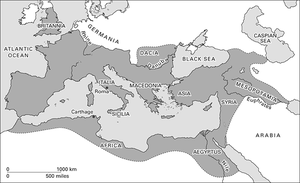
Roman empire. This map shows the expansion of the Roman empire at its greatest extent, in 117 ad. Rome expanded from a small settlement in the 6th century bc to rule most of the known European world by the early 2nd century ad. Having established control over Italy by c. 260 bc, Rome expanded to the east and west. By 133 bc all the territory formerly held by Carthage in the western Mediterranean and north Africa had been absorbed, together with Macedonia and Asia Minor in the east. Expansion continued for a further 150 years, the empire reaching its greatest extent in 117 ad, under Trajan. His successor, Hadrian, attempted to consolidate the empire behind fixed frontiers, drawing back to the Euphrates in the east and building the famous wall in Britain. However, less than 50 years later the decline of the empire had begun.
Source: MAPS IN MINUTES™ © RH Publications (1997)
The period when the Roman state and its overseas provinces were under the rule of an emperor, from the time of Augustus (27 bc) until 476 ad. The Roman empire was divided in 375 ad by Emperor Theodosius into the Western and Eastern empires. The term is often used to refer to all Roman territories during both the republic and the empire.
The city of Rome gradually gained power from the time of the Tarquins (6th century bc), subduing the Etruscans, Sabines, Samnites, and Greek settlers, and by the mid-3rd century bc, controlled Italy. It came into conflict with Carthage in the western Mediterranean and with the Hellenistic world in the east. Success in the Punic wars gave Rome its first overseas possessions in Sicily (241), Spain (201), and north Africa (146) and the Macedonian Wars eventually left Rome dominant in Macedonia, Greece, and parts of Asia Minor. Syria and Gaul from the Rhine to the Atlantic were added by the campaigns of Pompey and Julius Caesar and Egypt was annexed in 31 bc after the Battle of Actium. Augustus planned to consolidate the empire within natural boundaries, but in 43 ad Claudius invaded Britain. Trajan, in 106, made Dacia a province in response to raids across the Danube, although it was abandoned in 270. His annexation of Mesopotamia was very brief (114–117).
This vast empire was held together by secure communication and internal peace maintained by the Roman legions. Fleets kept the sea safe for shipping and a network of Roman roads, built to move troops quickly, facilitated trade, personal travel, and an imperial postal system. The development of a single legal system and the use of a common language (Latin in the west, Greek in the east) helped maintain unity. Roman cities flourished throughout the empire, assisted by efficient water and drainage systems. Roman influence and trade spread even further reaching India, Russia, south-east Asia, and through the Silk Road, China.
The success of the empire also led to its downfall, its sheer size contributing to its collapse, exacerbated by power struggles and the invasion of land-hungry migrating tribes. Rome was sacked by the Visigoths in 410, Carthage was conquered by the Vandals in 455, and in 476 Romulus Augustulus, the last emperor of the Western empire was deposed. The Eastern empire (Byzantine empire) lasted until 1453. Gibbon’s The History of the Decline and Fall of the Roman Empire (1776–81) is a classic account of the disintegration of imperial Rome.
- motion prediction
- motivation
- motor
- motorboating
- motor cell
- motorcycle
- motor gasoline
- motor generator
- motor neuron
- Motorola
- motor protein
- motor unit
- Mottelson, Benjamin Roy
- Mott insulator
- mottles
- mottling
- Mott, Sir Nevill Francis
- Mott transition
- motu
- Motuan
- Mo Tzu (5th)
- mould
- mouldic porosity
- moulin
- moulting